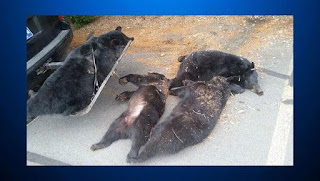Fours bears dead after eating red berries from English Yew plant
 |
| Photo provided by Pennsylvania Game Commission |
 |
| CBS News |
Family of bears likely killed from eating poisonous plantRemember that cool lunch debate scene in the film Jurassic Park, where the argument was about whether certain scientific choices are right or wrong ? There was one specific reference from the Paleobotanist character, Ellie Sattler, who stated the obvious when it comes to humans decision making when it comes to plant choices in the landscape:
"Well, the question is, how can you know anything about an extinct ecosystem and how could you assume you could ever control it ? You have plants here in this building that are poisonous, you pick them because they look good. But these are aggressive living things that have no idea whatYou can find this statement below in this YouTube clip and time mark 2:36 >>>centurycountry (think European Yew) they are living in and they will defend themselves, violently if necessary."
Over here in Sweden, the landscapers use this Yew plant everywhere. What appalls me is their choice to incorporate it within family housing complexes where there are large numbers of children, often unsupervised. The plant is also chosen for it's ornamental value in Christmas decorations such are wreaths which are hung on a door in the house. The deep evergreen foliage in contrast with the bright red berries are adittedly very attractive, but they are dangerous to children, especially young toddlers who will put anything in their mouths. English Holly is another one of these attractive ornamentals used at Christmas time, but their berries are also toxic. The white berries of Mistletoe is yet another toxic plant used on this holiday. Poinsettia is another. The scary thing is the red berry is sweet to the taste, but it's the seed that is toxic. I'll provide some reference examples below at the bottom of this post.
https://dengarden.com/gardening/Christmas-Plants-Safe-and-Poisonous
 |
| Image - Beto Frota - Oct 2007 |
 |
http://healthyhomegardening.com |
University of Maryland - Extension
Plant Profile: Toxic Yew
Try safer Natives from local area Native Plant Nurseries Heteromeles arbutifolia
 |
| Image - Bert Wilson - Las Pilitas Nursery |
 |
| Tehachapi Conservation Resource District |
Real life trageties from Yew berry ingestion
BBC: Ben Hines died after ingesting yew tree poison
New York Post - October 2016: This city park’s deadly berries nearly killed a 2 year-old-girl
http://www.nytimes.com/health/guides/poison/yew-poisoning/overview.html
Google is your friend. Seriously, there are pages of this stuff